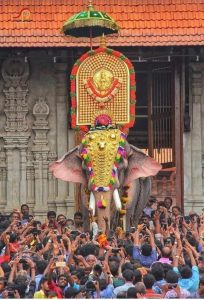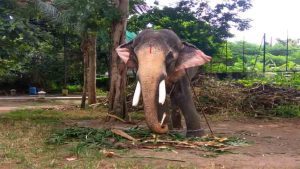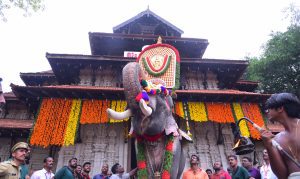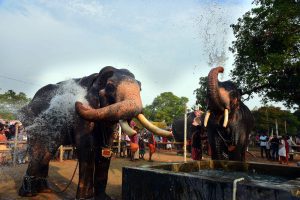While activists fight against it, the aged, partially blind pachyderm in his 60s — Raman — will be paraded at the Thrissur Pooram on 30 April.

Thechikottukavu Ramachandran during his halcyon days. (Supplied)
Despite the fact that Kerala is wilting under a scorching summer sun and the mercury hovering around the 45 degrees Celsius mark in most parts of the state, Thrissur city is all set to celebrate its glorious temple festival — Pooram — on 30 April with a grand display of caparisoned elephants, dazzling parasols, and percussion music.
The central Kerala city is already soaked in the festival spirit. In all likelihood, this year’s Pooram will be a magnificent spectacle, merging the spiritual and cultural essence of the region.
And as has been usual in the last few years, the focal point of the 36-hour-long festivities will be Thechikottukavu Ramachandran — better known as Raman — a domesticated, one-eyed elephant.

Raman being paraded at a temple festival. (Supplied)
Born in Assam around 1964 and brought up in Bihar, Raman, at 320.5 cm, is certified as India’s tallest living captive tusker. Across Kerala, his fanbase matches those of Mollywood superstars Mammootty and Mohanlal.
But Raman has a dark side to him — he is notorious for his occasional violent behaviour.
The otherwise-magnificent beast will remain caparisoned, carrying elaborate parasols on Pooram day and he will lead the day-time procession from Kuttoor Naithalakkavu Temple, carrying the deity.
However, the Pooram organisers have exempted him this year from the daily duty of ritualistically opening the southern gate of the main temple in Thrissur, marking the commencement of the festival.
The unpredictability of Raman’s nature has prompted the authorities to exempt him from this particular duty for the last two years.
Tusker Ernakulam Sivakumar of the Cochin Devaswom Board will take Raman’s place in the ceremonial opening of the southern gate.
But in the case of the Naithalakkavu temple authorities, there will be no Pooram procession without Raman. Temple committee joint secretary T Preman claims that he received clearance from a panel of veterinary experts to parade Ramana, despite the surging heat, his penchant for violent behaviour, and the expected large turnout of festival revellers.
Though the Kerala High Court enforced a blanket ban on parading Raman at temple and church festivals last year, a relaxation came later, where he could be paraded under unavoidable circumstances, if expert veterinarians — following long observation — find him fit to be paraded.
As far as Raman is concerned, he is in the autumn of life after crisscrossing the state’s length and breadth and being flaunted at temple festivals and church fests for the entertainment of so-called elephant lovers.
For him, there has been no let-up, even during the hot summer months, over the last several decades. The relentless moving around has taken a toll on the animal and Raman has suffered various ailments.
Now, the Thrissur Pooram and Raman’s participation have again triggered a debate. Animal lovers across the state want the elephant — now in his early sixties — to be allowed a retired life in any rehabilitation camp for aged captive elephants.
But Raman’s huge fanbase — extending worldwide — has summarily rejected the proposal. They feel that their Ekachathrathipathi — the only emperor — is inseparable from major temple festivals like the Thrissur Pooram.
They surmise that he can still carry the temple deities on his head, apart from blessing the eyes and hearts of devotees.
For over 18 years, except for the last two occasions, the elephant has pushed open the southern door of the iconic Vadakkunnathan Temple, declaring the beginning of the two-week-long Thrissur Pooram — billed as the mother of all festivals.
Despite being Kerala’s topmost celebrity jumbo, Raman has more than a dozen kills — including three fellow elephants — to his name. In February, South First reported the latest incident in which Raman turned unruly.
It was while parading him at the famous vela (festival) in Padoor in the Palakkad district on 24 February. His 63-year-old mahout — also ironically named Raman — sustained spinal injuries while trying to bring the elephant under control. Two others who helped the mahout control the elephant were also injured.
Despite the incident, the elephant was allegedly paraded using a loophole in a court order.
The Padoor incident also evoked a mixed response in Kerala. While Raman’s fans justified parading the pachyderm, others questioned the rationale behind taking him out to crowded places like festival grounds. The latter argued that the summer heat further irritated the animal.
Now, it’s April and Kerala is experiencing an unprecedented rise in the mercury, forcing the state government to issue guidelines to avoid sunburns and strokes.
Those opposed to parading Raman include playback singer and the lead vocalist of the band Agam, Harish Sivaramakrishnan, who urged festival organisers to be humane while deciding to parade elephants.
According to him, continued annual festival parades, despite the harsh climatic conditions, have made life hell for the partially blind and ailing Raman.
Irritated elephants are not known to show restraint, so humans must be gentle and avoid violating animal rights, says Sivaramakrishnan.
Animal lovers fear the elephant would be subjected to further cruelty by forcing him to be part of the Thrissur Pooram.
Despite initial attempts to avoid public attention, the Padoor incident snowballed into a major controversy in February last.
The temple management committee there then came up with a different explanation. It claimed it was not Thechikottukavu Ramachandran but a similar-looking elephant that ran amok.
The committee also said that the injuries to the mahout and two others were minor.

Thechikottukavu Ramachandran. (Supplied)
Additionally, the temple committee termed news reports as “organised lies” unleashed as part of deliberate attempts to defame the famous tusker.
While attempts to parade Raman at the Thrissur Pooram are being made, animal lovers and elephant rights activists are planning to approach the Kerala High Court for a permanent order prohibiting further parading of Raman, which has so far killed 13 people, including six mahouts.
But as far as Kerala’s major temples are concerned, Raman’s presence in festivals often involves prestige. Despite his blindness, caused reportedly by a bullhook during training, Raman enjoys wide admiration across the state.
According to elephant rights activist VK Venkitachalam, a high court order last year that banned parading Raman, also included a provision to constitute a monitoring committee to evaluate and facilitate parading it in unavoidable circumstances. He said that the provision was being misused to earn money.
Meanwhile, Thechikottukavu Ramachandran’s fans have declared that no legal process can keep him indoors. Raman is in demand nationwide as its majestic looks and size are unmatched.
Raman became the topic of a heated political debate in Kerala in May 2019, when the then-Thrissur District Collector, TV Anupama, banned parading him at the Thrissur Pooram, citing his failing health and kill record.
Several political leaders came out against Anupama. However, the state’s powerful Elephant Owners’ Association decided against parading their animals at the Pooram, in solidarity with Raman.
The collector was forced to relent and allow Raman to be paraded on select occasions — provided five trained mahouts managed him.
An elephant squad created a protective ring around the animal to keep fans at a distance of five metres.
Despite all this, the elephant ran amok and two revellers were injured in the ensuing mayhem. Venkitachalam added that firecrackers scare Raman, making him unruly.
Kerala has a long history of parading caparisoned elephants at temple ceremonies and other auspicious occasions. Even church festivals and mosque events employ elephants as an added attraction.

Ramachandran being paraded at Thrissur Pooram. (Supplied)
Raman changed several hands and responded to different names before the Thechikkottukavu Devaswom in Thrissur bought him for ₹70,000 on 31 October 1984. The temple became famous, thanks to the tusker.
As a revenue earner, Raman “financed” the construction of an auditorium, apart from helping the temple buy a truck and another tusker.
But it has been smooth sailing only at times. In 1998, Raman created headlines by attacking another celebrity elephant, Thiruvambadi Chandrasekharan, carrying the Sri Krishna idol of the Thiruvambadi Temple during the Thrissur Pooram.
Raman fatally gored Chandrashekhar while being paraded side-by-side at the festival. However, his fans justified his actions, claiming that Raman was provoked after being attacked by another tusker from behind.
Elephant experts opined that Raman was scared of strangers due to his failing eyesight. “He pushes people away physically out of fear, often with fatal consequences,” Venkitachalam weighed in.
According to the temple authorities, Raman could initially follow instructions only in Hindi and Bhojpuri. A mahout with no command over these languages lost his cool one day and hit the animal with a goad, permanently damaging its right eye.
After that incident, Raman became restive whenever people approached him. But Raman is still being paraded around in about 80 temple festivals a year.
Venkitachalam said that the beloved elephant should be allowed a “proper retirement life”, preferably at the Kottur rehabilitation camp for aged elephants in Thiruvananthapuram.
In the meantime, the number of captive elephants in Kerala is dwindling. Several celebrated elephants like Mangalamkunnu Kesavan, Mangalamkunnu Karnan, Paramekkavu Sree Padmanabhan, Guruvayur Padmanabhan and Thiruvambady Sivakumar have died.

An elephant at Thrissur Pooram. (Supplied)
The reason for the dwindling numbers is the high mortality rate among captive elephants, Venkitachalam explained. “On average, at least 25 captive elephants used to die every year in Kerala,” he said.
However, the state’s captive elephant population declined faster between 2008 and 2022, from 900 to 448, an almost 50 percent drop.
In recent years, 2018 saw the maximum number of deaths — 34. This year’s toll is currently at 12, while it was 29 in 2021 and 20 each in 2020 and 2019.
Mangalamkunnu MA Haridas, Kesavan’s owner, who lives in Mangalamkunnu village in Palakkad district, owned as many as 18 elephants in the 1996-98 period — among the largest private ownerships in the world. Today, he owns only four. “Palakkad district had 58 elephants six years ago, now it has only 28,” he told South First.
Apart from the high captivity death rate, Venkitachalam said that Kerala also has many surviving captive elephants at an advanced age, many of whom would soon die of natural causes.
Kerala Forest Department data shows that man-inflicted wounds are another reason for the death of captive elephants. As per the data, 16 elephants with visible injuries from poor treatment were seized from private owners in the last decade and rehabilitated at the retirement home in Kottur.
The wounds are inflicted by mahouts on sensitive parts of the animal’s body, including around the foot, sides of the hip and above the tusk, in a bid to manage them efficiently.
Even as captive elephants vanish rapidly in the state, Kerala’s fascination for the animal’s presence at festivities remains high.

An elephant being paraded at Thrissur Pooram. (Supplied)
The elephants are accorded demigod status — unseen elsewhere in the country — and some of the more popular ones have a fanbase that can compare with film stars.
With the threat of Covid-19 ebbing now, the demand for the elephant at various annual festivals has again increased.
The problem, according to V Nandakumar, president of the Cochin Devaswom Board — a socio-religious trust appointed by the state government to oversee the affairs of Hindu temples in the central districts of Ernakulam, Thrissur and Palakkad — is the non-availability of elephants needed during the rituals.
“We lost many of our celebrated elephants in recent years,” he said and added, “How can we maintain tradition at events like Thrissur Pooram without elephants? It is time we addressed the issue collectively.”
His solution: The government should promote donations of elephants by corporates and private individuals to centres of worship and immediately renew ownership transfers, or sale, of the beast.
In other words, Nandakumar wants the Wild Life (Protection) Act, 1972, to be amended.
Incidentally, in his farewell speech at the Rajya Sabha in April last year, actor-turned-BJP politician Suresh Gopi passionately appealed to relax the wildlife protection rules to allow the ownership and sale of elephants.
When contacted by South First, Kerala’s Temple Affairs Minister K Radhakrishnan said that he was aware of the gravity of the situation and would take up the matter with the Centre very soon.

A view of elephants on display at Thrissur Pooram. (Sourced)
Venkitachalam, however, alleges that ownership transfers continue illegally with the tacit support of the state government.
“There must be an immediate social audit of the health of all captive elephants,” he told South First.
Activists like Venkitachalam, who want better living conditions for captive elephants, oppose any move to bring in more elephants from outside, with the view that they would be mistreated in the state.

Jul 26, 2024

Jul 26, 2024

Jul 25, 2024

Jul 25, 2024

Jul 25, 2024

Jul 24, 2024